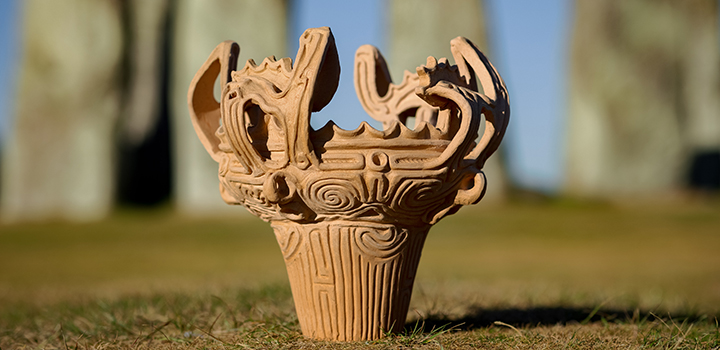‘Circles of Stone’ links astonishing prehistoric parallels of Japan and Britain
By: News archive

Britain’s first-ever exhibition of Japanese stone circles is opening at its most well-known prehistoric landmark, Stonehenge – complete with ancient national treasures from Japan.
‘Circles of Stone: Stonehenge and Prehistoric Japan’ is a partnership project with the Sainsbury Institute for the Study of Japanese Arts and Cultures at the University of East Anglia (UEA) and English Heritage. The exhibition, which opens on September 29, tells the remarkable story of two cultures 6,000 miles apart, through more than 80 objects.
Despite no evidence of contact at the time, Japan and both Britain and Ireland have fascinating prehistoric pasts, with a number of surprising parallels. Both are island archipelagos of similar size, flanking the Eurasian landmass at roughly the same latitude. This means that they have similar climates and available natural resources, which people exploited and adapted to create flourishing communities with distinct ritual and ceremonial practices. People in these areas were building stone circles, making elaborate pots and using flaked stone tools at the same time.
The star of the show is a 5,000-year-old Jōmon ‘Flame Pot’, on display for the first time ever outside of Japan. Made in the central part of Japan’s main island, this national treasure is highly decorated with features evoking blazing flames, flowing water, or perhaps the crests of cockerels.
The exhibition also includes fragments of exquisite clay figurines, known as Dogū. These human- or animal-shaped figurines made during the latter part of the Jōmon period (14,000–400 BC) have been found at stone circles. It has been suggested they may have represented Earth goddesses or spirits, for use in fertility or healing rituals. It is believed that many Dogū were intentionally broken and scattered during ceremonies.
Prof Simon Kaner, Executive Director of the Sainsbury Institute for the Study of Japanese Arts and Cultures and Director of UEA’s Centre for Japanese Studies, co-curated the exhibition.
Prof Kaner said: “Circles of Stone presents little-known aspects of Japanese archaeology that demonstrate similarity and equally intriguing diversity at either end of Eurasia. It also explores some fascinating links between British and Japanese archaeology over more than 100 years.”
The exhibition also explores more recent connections between Stonehenge and Japan through the art of Japanese woodblock printer Yoshijiro Urushibara, who worked in Britain in the 1920s, and British archaeologist William Gowland. Gowland used the techniques he had learnt in Japan to influence the way in which he carried out excavations and interpreted the evidence at Stonehenge at the dawn of the 20th century.
Martin Allfrey, Senior Curator for English Heritage, said: “Exploring what is happening elsewhere in the prehistoric world is key to understanding the significance of Stonehenge.
“It’s tantalising to look at what these extraordinary objects from Japan tell us about the similarities between these communities who, while thousands of miles apart, were perhaps ideologically closer than one might imagine.
“Equally intriguing is the fact that William Gowland’s experience working on archaeological sites in Japan at the end of the 19th century helped him to develop the first scientific study of Stonehenge and to formulate new theories about the building of Stonehenge and its alignment with the sun.
“We are thrilled to tell the story of this extraordinary place and time, and hope to bring a little bit of Japanese inspiration and wonder to the visitor centre at Stonehenge.”
English Heritage and UEA are grateful to the lenders from across Japan and the UK for these extraordinary objects, and for the generous support of the Ishibashi Foundation.
Admission to the exhibition will be free to Stonehenge ticket holders, English Heritage and National Trust England members and Local Resident Pass holders, as well as education groups.
Related Articles

Innovative AI solution to real-time seabed mapping earns UEA's School of Computing Sciences national recognition
UEA's School of Computing Sciences in-demand AI expertise has been recognised nationally after being named as one of Innovate UKs three finalists at their annual awards, following development of an innovative solution to real-time seabed mapping.
Read more